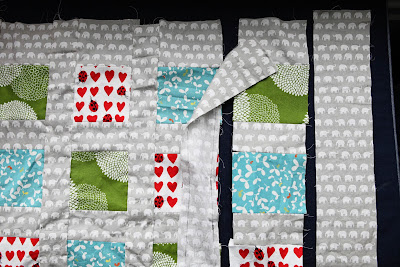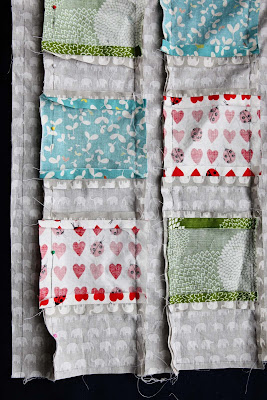I want to work on disciplined quilting. My recent quilts, the ones with curvy design were practice in non-straight edges, but does allow for a bit of sloppiness in terms of fitting pieces together. The Window Pane quilt, not an original design of my own at all, is a traditional pattern, very geometrical. It will be very easy to see if the pieces were not measured/ cut/ sewn accurately.
The original point of quilting (I assume) was to use up little scraps of fabric to form a big blankety item, when large fabric pieces were scarce. So there was no luxury of large, curving pieces - instead, one could gather lots of little squares, rectangles and triangles. While I do have large bolts of fabric, this is a nod to the days of fabric scraps. BTW, this is a continuing story; if I wait until the quilt is done, I will have forgotten the details of How To and Progress.
1. Drafting Design. I'd seen the window pane quilt around before, but didn't have a pattern, so I drew one out, and applied dimensions to the squares etc so that it would wind up to be baby blanket size. Note that this design is NOT simply a bunch of squares sewn on to one large piece of gray elephant fabric - that would be Applique, not Quilting. The elephant fabric will be cut into little rectangles that will fit between all the colored squares. It'll look way better this way, though it's much more work. There will be 5 loooong rectangles to fit between the 4 columns of squares and 24 mini rectangles to fill in the rest of the spaces.

2. Fabric Decisions. The background fabric is the least distracting, so the colored squares stand out. I toyed with some other fabrics before deciding on these three. Others were rejected on the basis of being too dark or light, or for having too large a print. These three have a saturated medium tone color, having similarly stylized blocky prints with white worked into the design.
3. Cutting. My first use of the fabric cutting wheel. Like a pizza cutter. Much easier on carpel tunnel hands than scissors, and way faster. I also used a fabric pencil (draws easily and washes out on fabric), and measured out squares while incorporating space for seams. My squares are 4'x4', thus I cut out 5'x5' squares, assuming a consistent seam of 1/2'. Use large cutting board and long ruler.
4. This awesome tool: the Bias Tape Maker! I've not used it yet, but I'm really excited about it. Bias (fabric) Tape is not sticky like tape, but is a long strip of folded fabric to sew along fabric edges to prevent fraying. Like on blanket edges. This tool folds fabric strips, and you iron the folds down as the fabric emerges from the end. If you've ever tried to make bias tape by hand, you'll appreciate this little gadget! Oh, why "bias"? Supposedly you use fabric cut on the bias (ie, diagonal to grain) - better integrity or something. At this stage, I'm happy to use unbiased fabric strips to make tape. I am looking forward to putting such tape along the edge of my blanket, but that will be the last step.

















